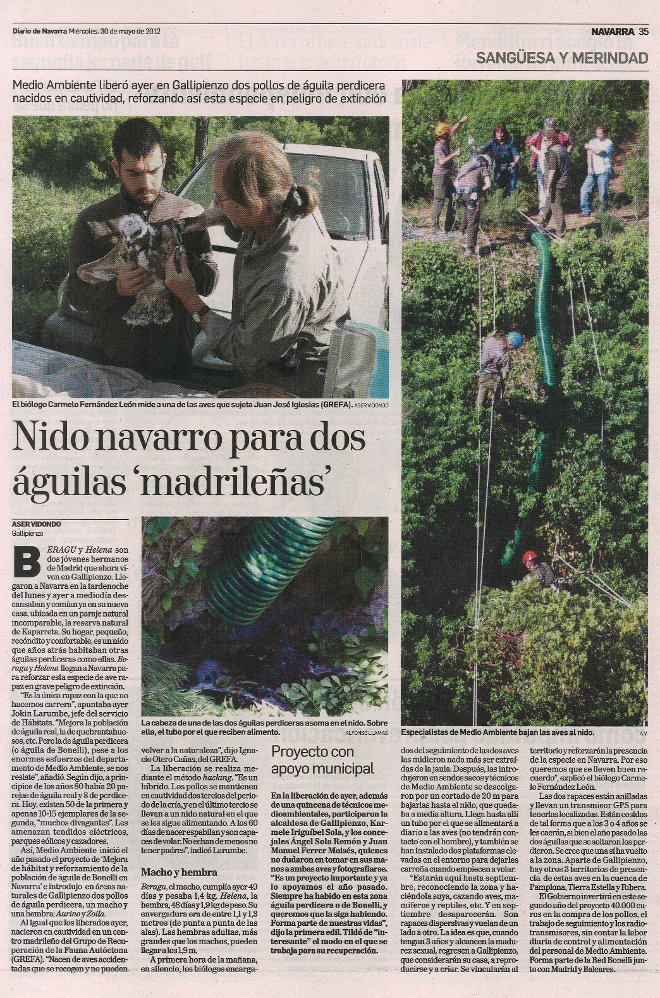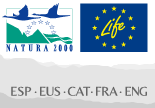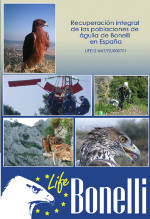
- Details
- Created: 09 March 2015
- Hits: 3561

For 30 years, measures have been implemented for legal protection, the protection and management of natural landscapes and through the implementation of EU Birds and Habitats Directives that have supported the species. The factor which most affected the raptors was their legal protection in the 70s, the incorporation of the EU Directives on Birds and Habitats and the laws on modification of overhead electrical cables.
Nevertheless, since 2005 (when homogeneity was achieved in the Bonelli's Eagle censuses to establish a comparative in its evolution) a decline in the population of this species has been noted. It is important that in these censuses, the marginal areas the species distribution have seen a decrease and even local extinctions. These are unequivocal "early warning signs,” which must be considered in vulnerable species and dealt with decisively. If this does not occur, a species in danger of extinction at a national level would be faced (as it is listed in certain CCAA) and later a more severe problem would be encountered, which would consume more economic resources and the solution would span decades.
In the last census of 2006, it was estimated that approximately 45% of the Spanish population is located in Andalusia. Even in Andalusia, where the population is higher and around 350 pairs can be found, there have been significant reductions in certain areas across Jaén.
The decrease of the species has led to the creation of a working group within the Flora and Fauna Committee of the National Commission for Nature Conservation and a national strategy draft has been developed for the conservation of the species.
In the particular case of the Bonelli's Eagle (Hieraaetus fasciatus), eight LIFE projects have been implemented in Spanish regions and another in Portugal. In all these projects, actions have been carried out regarding the reduction of dangers and causes of death (mending of overhead electrical cables, nest observation, increasing prey species, media awareness campaigns, etc.)
However, these have all been set up in only one province, not divided amongst other Spanish regions nor other countries (as is the case with LIFE BONELLI). The demographic analysis has been approached on the basis of reproduction and mortality in each population, without lending as much importance to the rates of immigration, emigration, and drain and source areas. This aspect has limited the understanding of the problems confronted by the Iberian population, addressed from a local rather than metapopulation perspective.
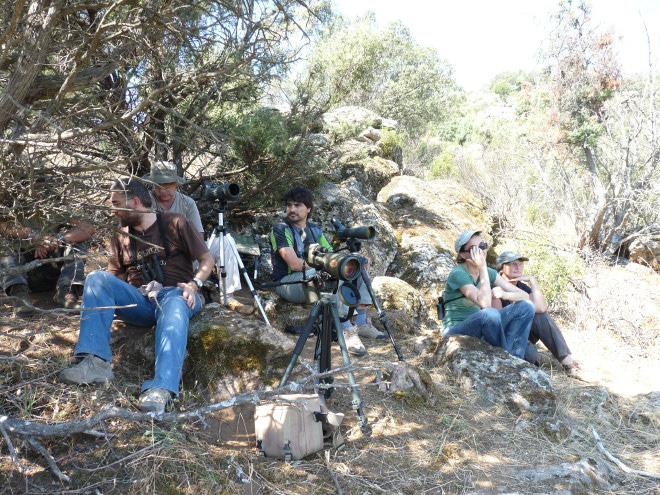
Efforts carried out in the mentioned areas are:
Navarre:
Since 1996, within the framework of the species Recovery Plan and through development of Annual Performance Projects, extensive monitoring has been implemented, including the control of the population, reproductive as well as varying, and the observation of the reproduction of established pairs. This has enabled the discovery of the precise autecology and evolution of the regional population as well as the establishment of repair measures.
This effort intensified between 1997 and 2000 due to the development of Project LIFE (LIFE96NAT/E/3114), which fundamentally developed awareness and promotion measures, monitoring of nesting areas to avoid human disturbance, mending of overhead electrical cables across the land to reduce the risk of a changing population, regulation of hunting activities and control of activities that could affect the nesting areas, marking of chicks and radio-monitoring of specimens to determine the spatial use, and evaluation of the environmental impact of infrastructures.
In 2000, the process of clearing abandoned farming land was carried out, with the aim of increasing diversity, preventing the homogenization of the brushwood and favouring the presence of the prey species.
With awareness of the fact that electrocution and collision with electrical cables is one of the main causes of death, between 1992 and 2012 a total of 4,536 supports were mended along 1,387 km of distribution lines, and 851 exposed wires and 167 km in transport and distribution lines were marked. The total investment was 3,983,474 €.
In spite of the efforts to adequately influence the primary causes of unnatural deaths and the protection of nesting areas within the Natura 2000 Network, it has not been enough to counter the negative demographic trend of the species.
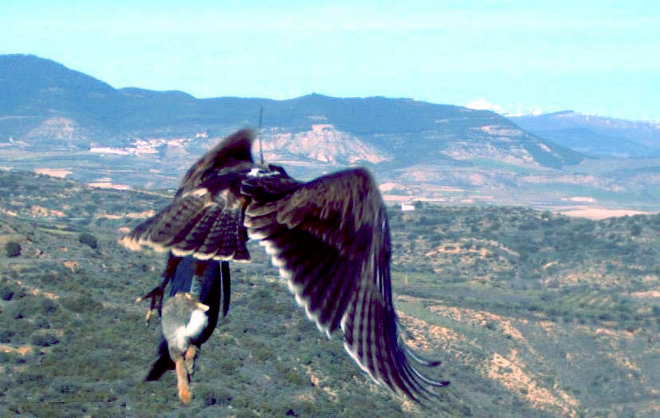
Madrid:
In Madrid, there has been a concerted effort to prevent the risk of electrocution. Given the age of some measures, a renewal would be necessary as certain modifications have not been as effective. Despite the lack of a formal recovery plan, a viability study was carried out regarding the actions required to improve the population situation and a second viability study was created to strengthen this population.
At the same time as this study, a captive breeding programme was created in the GREFA facilities and the preparation of strengthening and reintroduction protocols were improved. Currently, there are 9 pairs in the GREFA facilities and other individuals still without a partner. To date, 14 chicks have been produced.
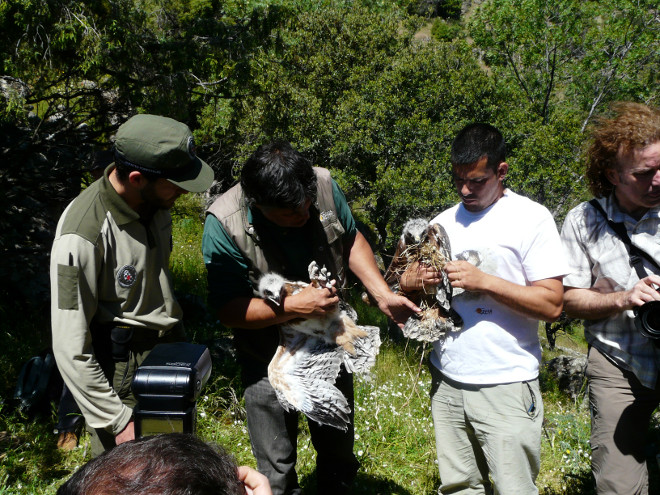
The Balearic Islands:
For 20 years in the Balearic Islands, awareness campaigns have been conducted together with disciplinary measures with the aim of eliminating the systematic hunting of raptors through shooting and trapping.
In 2007, the Balearic Islands Government decided to start the process of reintroducing the species in Mallorca. In 2008, a viability study and reintroduction plan was prepared and published in the official journal of the Balearic Islands in August, 2009. The experimental phase began with the preparation of release protocols, a study of habitat availability, a demographic evolution forecast, the preparation of the first release facilities, the first experimental releases, and tasks for awareness.
This continues with the modification of overhead electrical cables by means of a collaboration agreement with ENDESA. Since the 90s, more than 2,000 dangerous electrical components have been repaired.
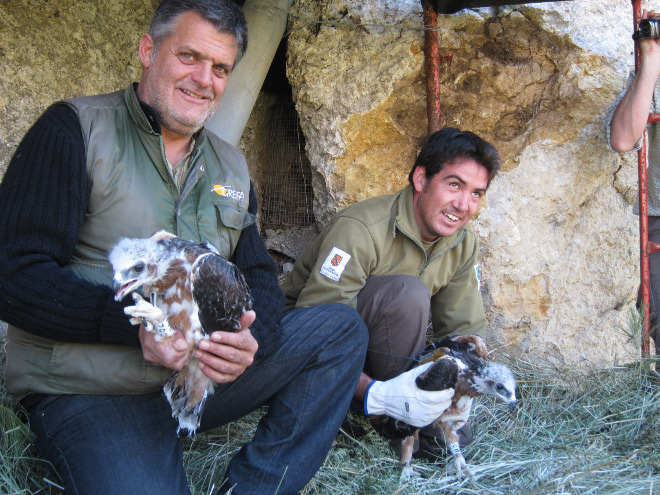
Álava:
Within the current “Action Plan for the Recovery of the Bonelli's Eagle in Álava”, the LIFE Project was developed (LIFE00 NAT/E/7336). Between 2001 and 2004, procedures were carried out for:
1· Protection of the nesting and breeding areas.
2· Modification of dangerous electrical cables, establishing agreements with electric companies.
3· Monitoring of nesting areas and regulation of risks to prevent reproductive failures.
4· Assessment of reproductive period and reproduction, reasons for reproductive failures and rates and causes of death among adults.
5· Increase in prey populations by means of habitat management and regulation of hunting.
6· Development of awareness campaigns for various sectors.
These improvements have contributed to maintaining and securing the only nesting pair by removing the majority of threats to the species.
Andalusia:
For the first time, an intensive, coordinated and equal effort was made in 2005 to register the entire Bonelli's Eagle population in Andalusia. Between 321 and 347 breeding pairs were discovered, practically half of the Spanish population. 52.4% of pairs are in Natura areas. Since February 2004, the “Development Project for the Conservation of the Bonelli's Eagle in Andalusia” has been developed, whose aim is to increase the probability of long-term existence of the Andalusian population.
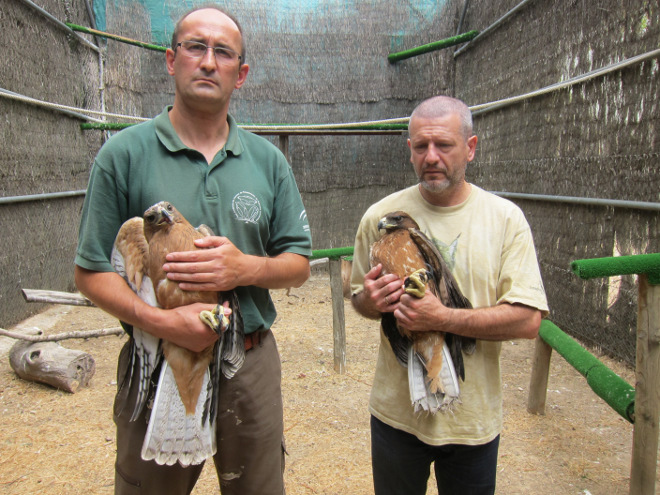
Bonelli Network 2010-2012
At the same time as these conservation procedures (2010-2012), experimental releases of specimens were carried out in the project areas in order to determine their release potential and to adapt hacking methods and flight cages to the specificities of the species.
The first cases were carried out in Madrid in 2010 with the release of 2 chicks using the hacking method; of these two, one regularly visits the release area. In 2011, 4 chicks were released (2 born in captivity), of which 2 died from electrocution and the others continue to live near the area after a brief spell of dispersal. In 2012, 3 birds were captured by a fox, while an older juvenile that was released (after being in cage) flew well.
In 2011 and 2012, in Navarre, two birds were released without any problems. Although the birds in 2011 lost their transmitters, at least one of them has been seen in the release area. The juveniles released in 2012 are currently in the dispersal phase.
In Mallorca, 4 juveniles were reintroduced by hacking in 2011 and 2 in 2012. In addition, a new release method for fledglings was attempted, with the release of two juveniles in 2011 by means of flight cage that was used to release two other birds in 2012. In 2011, two released chicks were electrocuted by a support that was subsequently modified. Given the characteristics of the island and despite being young creatures, not one of them has left the island and territorial behaviour has already been observed. These releases have been successful as much in the releases themselves as the ability of the birds to adapt to their new island surroundings.
In conclusion of these first reintroductions, the most suitable method of releasing has been established for each age group and nothing suggests that death rate of the reintroduced animals is higher than that of the natural population; on the contrary, it seems to be lower.
